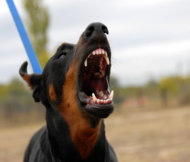By Dr. Mary Fuller | vetstreet.com
 Thinkstock
ThinkstockIn the years when I had two
Shiba Inus, few things unnerved me more than the sight of a playful
Golden Retriever - sans leash - bounding toward us, tail shimmying side to side, tongue dangling.
Inevitably, the owner would wave and holler, "It's OK, my dog is friendly." There was never time for me to shout, "But my dogs aren't!" before we'd be caught up in a maelstrom of fangs and claws and fur.
Grrrrrrrr.
On most walks, my dogs were the epitome of gentility. They'd sit calmly while toddlers swatted their faces with sticky hands. They'd roll over for belly rubs from strangers. They'd sniff the nether parts of other dogs. But a dog off leash? It was an invitation for an all-out brawl. And there were plenty of them.
Dogs Give Us Clues
Many things can spark aggression in an otherwise peaceful family dog: being abruptly woken from a deep sleep; manipulating a painful,
arthritic joint; or, in the case of my dogs, having an uncontrolled dog invade their personal space.
Unfortunately, owners often don't realize that dogs may not feel like interacting when they want them to, according to a recent presentation at the
Western Veterinary Conference by
Dr. Ilana Reisner, a board-certified veterinary behaviorist. And that can lead to aggression and injury to owners, children and other pets.
Aggression can often be avoided if owners read the signs their dogs are giving them, Dr. Reisner says. In particular:
A yawning dog may be a stressed dog. Dogs who are feeling anxious will often yawn, lick their lips or pant. They may pin their ears back and avoid eye contact. During petting, these dogs may stiffen up or freeze to show their discomfort. In these cases, it's best to give them some space.
Does your dog want a belly rub - or want you to back off? If a dog approaches you before rolling on her back, she may just want a belly rub. But when you initiate the interaction and she rolls on her back, it may be a sign of fear or submission and may be her way of asking you to stop.
Don't assume a wagging tail means a friendly dog. While most people presume that tail wagging is a sign of happiness, depending on the context, it can also signal fear, stress or that a dog may feel threatened.
Avoid Aggression Triggers
To minimize the risk of aggression, Dr. Reisner recommends avoiding circumstances where a dog may have bitten in the past. Additional tips include:
Avoid threatening body language. Some human actions may seem friendly to us but can be perceived as threatening to a dog. In general, dog owners should avoid direct eye contact, bending over a dog, and lifting or holding a dog when they aren't comfortable with it.
Let sleeping dogs lie. Dogs who are startled from sleep may bite as a defense. Other dogs who are awake but resting may growl when approached if they are in a high-value resting spot, such as on the couch or beneath furniture. Still others may be content to be curled on the couch next to an owner but will growl when a spouse or child approaches because a resource they're guarding is threatened.
Use verbal commands instead of hands. Dogs who are poked, prodded or grabbed by the collar to get them to move may snap in response. It's always better to use commands such as "off" and "come" or offer treats to induce them to move on their own.
Trade possessions instead of taking them away. A dog who is eating food or playing with a toy may not understand why it is abruptly taken away. Subsequent removal of objects may make the dog more apt to growl or bite to defend his possessions. A better approach is to reward the dog for relinquishing an object by giving her something in return, whether it's a treat or praise.
Never leave dogs unsupervised with children. Interactions between small children and pets can be unpredictable. Children may climb on pets, pull at their hair and shriek in high voices, which can scare any dog. Unless at least one adult can be in the room with the child and the dog, it's best to keep them separated.
Finally, for those dogs who may be uncomfortable with interactions on walks, Dr. Reisner recommends tying a yellow ribbon on the dog's leash. The yellow ribbon creates awareness that this dog should not be approached on walks, either because of potential aggression problems or simply because she has health issues or is in training. More information about this approach can be found at
theyellowdogproject.com.
More on Vetstreet.com
 ThinkstockIn the years when I had two Shiba Inus, few things unnerved me more than the sight of a playful Golden Retriever - sans leash - bounding toward us, tail shimmying side to side, tongue dangling.
ThinkstockIn the years when I had two Shiba Inus, few things unnerved me more than the sight of a playful Golden Retriever - sans leash - bounding toward us, tail shimmying side to side, tongue dangling. ThinkstockIn the years when I had two Shiba Inus, few things unnerved me more than the sight of a playful Golden Retriever - sans leash - bounding toward us, tail shimmying side to side, tongue dangling.
ThinkstockIn the years when I had two Shiba Inus, few things unnerved me more than the sight of a playful Golden Retriever - sans leash - bounding toward us, tail shimmying side to side, tongue dangling.
No comments:
Post a Comment